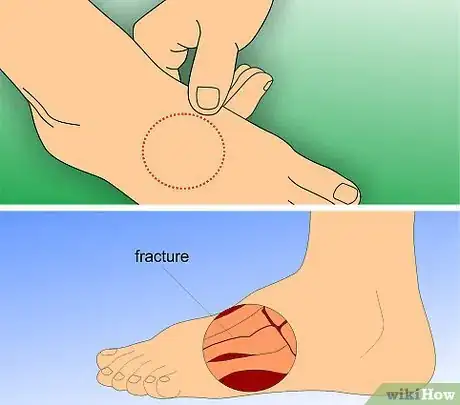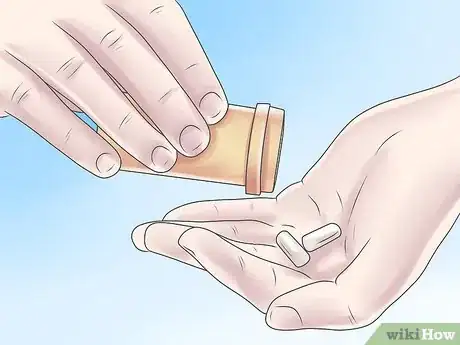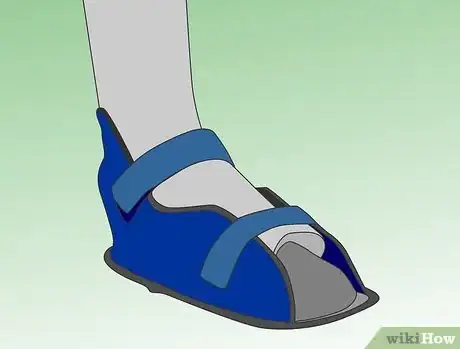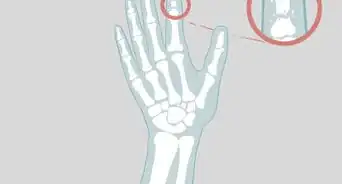This article was co-authored by Neal Blitz, DPM, FACFAS. Dr. Neal Blitz is a Podiatrist and Foot & Ankle Surgeon who runs private practices in New York City and in Beverly Hills, California. Dr. Blitz is “The Bunion King®” and is the creator of the Bunionplasty® Procedure (plastic surgery for bunions) which has revolutionized bunion surgery. He has over 17 years of podiatric experience and specializes in minimally invasive foot and ankle surgery. Dr. Blitz received his DPM from the New York College of Podiatric Medicine, then completed a residency focused on Elective & Reconstructive Foot & Ankle Surgery at the Swedish Medical Center, and was awarded an AO Trauma fellowship in Dresden, Germany, focused on trauma and reconstructive techniques. He is board certified in Foot Surgery and Reconstructive Rearfoot & Ankle Surgery and is also a Diplomate of the American Board of Foot & Ankle Surgery and a fellow of the American College of Foot & Ankle Surgeons (FACFAS).
wikiHow marks an article as reader-approved once it receives enough positive feedback. This article received 19 testimonials and 98% of readers who voted found it helpful, earning it our reader-approved status.
This article has been viewed 802,577 times.
A stress fracture is a small crack in a bone caused by repetitive force or stress. They often result from overuse of the bone. Stress fractures can cause significant discomfort, especially in areas of weight-bearing use, such as the foot. They are most common in the feet and lower legs. Symptoms include swelling and pain that become worse over time. Stress fractures can become very serious if left untreated, so it is important to seek appropriate medical care. If you are at risk of developing stress fractures, you can take measures to prevent them.
Steps
Treating a Stress Fracture
-
1Recognize the symptoms of a stress fracture in your foot. The first sign of a stress fracture may be a slight discomfort towards the front of the foot. This is the part of the foot that often takes the brunt of stress during repetitive activities. Over time, you may notice other symptoms, such as swelling of the foot or ankle, tenderness to the touch at the injury site, and sometimes bruising.[1]
- Many times, pain from stress fractures is very slight, and you may only feel it during long periods of exercise, running, or working out. As soon as you stop your activity, the pain may vanish. For this reason, you may not immediately suspect a fracture.
-
2Stop exercising if you notice stress fracture symptoms. As soon as you notice pain in your foot, stop whatever you were doing when the symptoms started. If the pain goes away as soon as you stop using your foot and returns when you resume your activities, you may have a stress fracture.[2]Advertisement
-
3Avoid taking painkillers, if you can. Common over-the-counter painkillers, especially NSAIDs (non-steroidal anti-inflammatory drugs) such as ibuprofen (Motrin) and naproxen (Aleve), may delay bone healing. Acetaminophen (Tylenol) may also disrupt healing. If you can, manage your pain with other methods (such as ice packs or light compression), unless your doctor recommends otherwise.[3]
-
4Treat the area with the RICE method. When you have a stress fracture, appropriate first aid can help minimize inflammation and prevent further injury. The most effective form of first aid for a stress fracture is the RICE protocol, which stands for rest, ice, compression, and elevation.[4] Immediately after you are injured and while you are waiting to get medical care, do the following:[5]
- Rest your injured foot as much as possible. If you must walk around or put weight on your foot, wear a supportive shoe with a thick sole.[6]
- Ice your foot. Apply an ice pack to the injured area for 20 minutes at a time, with 20-minute breaks in between. Wrap the ice in cloth to protect your skin.
- Compress the area gently with a soft, loosely-wrapped bandage.
- Elevate your foot, keeping it above the level of your heart. Try lying down on a couch with your foot propped up on the armrest, or lying in bed with your foot propped on a couple of pillows.
-
5See your physician right away. If you have symptoms of a stress fracture, schedule an appointment with your doctor as soon as possible. Since stress fractures often do not show up on X-rays, your doctor may order other types of imaging tests, such as an MRI or nuclear bone scan.
- You will likely be prescribed a walking boot or crutches to help minimize stress on the fractured bone while it heals.
-
6Get some rest. Continue to follow your doctor's advice about wearing the boot or using the crutches. It is imperative for proper healing to keep weight and force off the injured foot. Keep your feet up as much as possible and make sure to get adequate sleep. Most healing takes place when you are sleeping, and there is extra energy from the lack of use of other body functions.
-
7Refrain from exercise that impacts your feet for 6-8 weeks. Healing a foot stress fracture is not a quick process by any means. The longer you can stay off your feet, however, the faster the fracture will heal. Don't even think about running or playing ball or exercising until it is completely healed.
- Depending on their severity, some stress fractures take longer to heal than others. Follow your doctor’s advice about when you can safely start exercising again without reinjuring the fracture and delaying the healing process.
-
8Focus on exercising other parts of your body while your foot heals. You may not need to give up on exercise altogether while your fracture is healing. Talk to your doctor or a physical therapist about doing low-impact exercises (e.g., swimming), or strength training that focuses on your upper body.[7]
-
9Follow up with your doctor to make sure the fracture has healed. You will need to schedule at least 1 follow-up visit with your doctor. They may want to X-ray your foot once more to confirm it has fully healed before you return to your normal exercise routine.
- X-rays taken later in the healing process can sometimes reveal fractures that were not visible immediately after the injury. This is because a callus forms on the bone during the healing process, creating a thickened area at the site of the fracture.
Preventing Stress Fractures
-
1Assess your risk of developing stress fractures. Some people are more likely than others to get stress fractures due to occupation, lifestyle, or health factors. People who experience repetitive stress on their feet, such as runners, dancers, or athletes, are at especially high risk. People with health conditions that decrease bone density, such as osteoporosis or vitamin D deficiency, are also at risk.[8]
- If you’ve had a stress fracture before, you’re at greater risk of developing another one.[9]
- Women are more likely to develop stress fractures than men, especially if they experience abnormal or irregular menstrual periods.[10]
- Long-term use of certain medications, including glucocorticoids (a type of steroid), many hormonal medications, and some cancer drugs, can affect bone density. Ask your doctor if any of your current medications put you at risk.[11]
-
2Be careful when you exercise. Stress fractures are a common occurrence for people with intense exercise routines. Doctors therefore recommend never increasing the intensity of your workout by more than 10% per week.[12] Take these precautions to minimize your risk of stress fractures:
- Warm up and stretch thoroughly before you exercise.
- Take frequent breaks to give your body and bones a break. If you feel uncomfortable or experience pain during exercise, stop immediately.
- Use good, well-maintained exercise equipment to help prevent stress fractures. Stress fractures may occur when your equipment forces you to adopt improper technique.
- Incorporate strength training into your workout routine to build bone mass and strengthen the muscles in your feet and ankles.
-
3Talk to your doctor about adjusting your diet. Dietary deficiencies can make your bones weaker and more susceptible to stress fractures. Make an appointment with your doctor or a registered dietitian for advice on changing your diet or incorporating dietary supplements.[13]
- A diet rich in calcium and vitamin D can help improve bone density and prevent stress fractures.
Expert Q&A
Did you know you can get expert answers for this article?
Unlock expert answers by supporting wikiHow
-
QuestionCan you walk with a stress fracture in the foot?
 Neal Blitz, DPM, FACFASDr. Neal Blitz is a Podiatrist and Foot & Ankle Surgeon who runs private practices in New York City and in Beverly Hills, California. Dr. Blitz is “The Bunion King®” and is the creator of the Bunionplasty® Procedure (plastic surgery for bunions) which has revolutionized bunion surgery. He has over 17 years of podiatric experience and specializes in minimally invasive foot and ankle surgery. Dr. Blitz received his DPM from the New York College of Podiatric Medicine, then completed a residency focused on Elective & Reconstructive Foot & Ankle Surgery at the Swedish Medical Center, and was awarded an AO Trauma fellowship in Dresden, Germany, focused on trauma and reconstructive techniques. He is board certified in Foot Surgery and Reconstructive Rearfoot & Ankle Surgery and is also a Diplomate of the American Board of Foot & Ankle Surgery and a fellow of the American College of Foot & Ankle Surgeons (FACFAS).
Neal Blitz, DPM, FACFASDr. Neal Blitz is a Podiatrist and Foot & Ankle Surgeon who runs private practices in New York City and in Beverly Hills, California. Dr. Blitz is “The Bunion King®” and is the creator of the Bunionplasty® Procedure (plastic surgery for bunions) which has revolutionized bunion surgery. He has over 17 years of podiatric experience and specializes in minimally invasive foot and ankle surgery. Dr. Blitz received his DPM from the New York College of Podiatric Medicine, then completed a residency focused on Elective & Reconstructive Foot & Ankle Surgery at the Swedish Medical Center, and was awarded an AO Trauma fellowship in Dresden, Germany, focused on trauma and reconstructive techniques. He is board certified in Foot Surgery and Reconstructive Rearfoot & Ankle Surgery and is also a Diplomate of the American Board of Foot & Ankle Surgery and a fellow of the American College of Foot & Ankle Surgeons (FACFAS).
Board Certified Podiatrist You should rest your foot as much as possible. If you have a stress fracture in the ball of your foot, you may just need to limit your activity and wear thick-soled, supportive shoes while your foot heals. If your stress fracture is closer to the arch, you may need to be in either a boot or a cast with crutches.
You should rest your foot as much as possible. If you have a stress fracture in the ball of your foot, you may just need to limit your activity and wear thick-soled, supportive shoes while your foot heals. If your stress fracture is closer to the arch, you may need to be in either a boot or a cast with crutches. -
QuestionHow do I start exercising after a stress fracture?
 Kevin Stone, MDDr. Kevin Stone is an orthopaedic surgeon and the founder of The Stone Clinic, a leading orthopaedic surgery, sports medicine, and rehabilitation clinic in the San Francisco Bay Area. With over 30 years of experience, Dr. Stone specializes in knee, shoulder, and ankle repair, using biologic reconstruction and joint replacement. He holds a BS in Biology from Harvard University and a Doctor of Medicine (MD) from the University of North Carolina at Chapel Hill. Dr. Stone completed his residency in Internal Medicine and Orthopaedic Surgery at Harvard University and in General Surgery at Stanford University. He then completed a fellowship in Orthopaedic Research and Surgery at the Hospital for Special Surgery and Tahoe Orthopaedics. He lectures around the world as an expert in cartilage and meniscal growth, replacement, and repair and holds over 40 U.S. patents on novel inventions to improve healthcare. Dr. Stone is a physician for Smuin Ballet and has served as a physician for the U.S. Ski Team, the U.S. Pro Ski Tour, the United States Olympic Training Center, and World Pro Ski Tour.
Kevin Stone, MDDr. Kevin Stone is an orthopaedic surgeon and the founder of The Stone Clinic, a leading orthopaedic surgery, sports medicine, and rehabilitation clinic in the San Francisco Bay Area. With over 30 years of experience, Dr. Stone specializes in knee, shoulder, and ankle repair, using biologic reconstruction and joint replacement. He holds a BS in Biology from Harvard University and a Doctor of Medicine (MD) from the University of North Carolina at Chapel Hill. Dr. Stone completed his residency in Internal Medicine and Orthopaedic Surgery at Harvard University and in General Surgery at Stanford University. He then completed a fellowship in Orthopaedic Research and Surgery at the Hospital for Special Surgery and Tahoe Orthopaedics. He lectures around the world as an expert in cartilage and meniscal growth, replacement, and repair and holds over 40 U.S. patents on novel inventions to improve healthcare. Dr. Stone is a physician for Smuin Ballet and has served as a physician for the U.S. Ski Team, the U.S. Pro Ski Tour, the United States Olympic Training Center, and World Pro Ski Tour.
Board Certified Orthopaedic Surgeon
-
QuestionHow can I take care of a stress fracture in my foot?
 Neal Blitz, DPM, FACFASDr. Neal Blitz is a Podiatrist and Foot & Ankle Surgeon who runs private practices in New York City and in Beverly Hills, California. Dr. Blitz is “The Bunion King®” and is the creator of the Bunionplasty® Procedure (plastic surgery for bunions) which has revolutionized bunion surgery. He has over 17 years of podiatric experience and specializes in minimally invasive foot and ankle surgery. Dr. Blitz received his DPM from the New York College of Podiatric Medicine, then completed a residency focused on Elective & Reconstructive Foot & Ankle Surgery at the Swedish Medical Center, and was awarded an AO Trauma fellowship in Dresden, Germany, focused on trauma and reconstructive techniques. He is board certified in Foot Surgery and Reconstructive Rearfoot & Ankle Surgery and is also a Diplomate of the American Board of Foot & Ankle Surgery and a fellow of the American College of Foot & Ankle Surgeons (FACFAS).
Neal Blitz, DPM, FACFASDr. Neal Blitz is a Podiatrist and Foot & Ankle Surgeon who runs private practices in New York City and in Beverly Hills, California. Dr. Blitz is “The Bunion King®” and is the creator of the Bunionplasty® Procedure (plastic surgery for bunions) which has revolutionized bunion surgery. He has over 17 years of podiatric experience and specializes in minimally invasive foot and ankle surgery. Dr. Blitz received his DPM from the New York College of Podiatric Medicine, then completed a residency focused on Elective & Reconstructive Foot & Ankle Surgery at the Swedish Medical Center, and was awarded an AO Trauma fellowship in Dresden, Germany, focused on trauma and reconstructive techniques. He is board certified in Foot Surgery and Reconstructive Rearfoot & Ankle Surgery and is also a Diplomate of the American Board of Foot & Ankle Surgery and a fellow of the American College of Foot & Ankle Surgeons (FACFAS).
Board Certified Podiatrist You really need to limit your activity as much as possible. Follow the RICE protocol, which means rest, ice, compression, and elevation. Depending on where the injury is, you may be able to immobilize the area simply by resting and wearing thick-soled shoes, or you may need to wear a cast and use crutches while it heals.
You really need to limit your activity as much as possible. Follow the RICE protocol, which means rest, ice, compression, and elevation. Depending on where the injury is, you may be able to immobilize the area simply by resting and wearing thick-soled shoes, or you may need to wear a cast and use crutches while it heals.
Warnings
- Stress fractures are often difficult to diagnose, as the breaks are very fine and often do not show up on initial X-rays. If you have symptoms of a stress fracture and your primary care doctor is unable to arrive at a definitive diagnosis, ask for a referral to a podiatrist/foot specialist.⧼thumbs_response⧽
References
- ↑ https://orthoinfo.aaos.org/en/diseases--conditions/stress-fractures-of-the-foot-and-ankle/
- ↑ https://orthoinfo.aaos.org/en/diseases--conditions/stress-fractures-of-the-foot-and-ankle/
- ↑ http://www.acsm.org/public-information/sportsmedicinebasics/stress-fractures
- ↑ Neal Blitz, DPM, FACFAS. Board Certified Podiatrist. Expert Interview. 22 April 2020.
- ↑ https://orthoinfo.aaos.org/en/diseases--conditions/stress-fractures-of-the-foot-and-ankle/
- ↑ Neal Blitz, DPM, FACFAS. Board Certified Podiatrist. Expert Interview. 22 April 2020.
- ↑ https://emedicine.medscape.com/article/309106-treatment
- ↑ https://orthoinfo.aaos.org/en/diseases--conditions/stress-fractures-of-the-foot-and-ankle/
- ↑ https://www.mayoclinic.org/diseases-conditions/stress-fractures/symptoms-causes/syc-20354057
- ↑ https://www.mayoclinic.org/diseases-conditions/stress-fractures/symptoms-causes/syc-20354057
- ↑ https://www.accp.com/docs/bookstore/psap/p7b03.sample04.pdf
- ↑ https://orthoinfo.aaos.org/en/diseases--conditions/stress-fractures-of-the-foot-and-ankle/
- ↑ https://orthoinfo.aaos.org/en/diseases--conditions/stress-fractures-of-the-foot-and-ankle/
About This Article
To treat a stress fracture in your foot, make a doctor's appointment as soon as possible since stress fractures can become serious if left untreated. While waiting for your appointment, rest your foot as much as possible. Additionally, ice the affected area for 20 minutes at a time, and compress the area with a loose bandage. You should also elevate your foot above the level of your heart to increase circulation to the area. If you can, avoid using over-the-counter painkillers during this time as they can delay the healing process. To learn how to exercise while allowing your foot to heal, keep reading!









































































Medical Disclaimer
The content of this article is not intended to be a substitute for professional medical advice, examination, diagnosis, or treatment. You should always contact your doctor or other qualified healthcare professional before starting, changing, or stopping any kind of health treatment.
Read More...